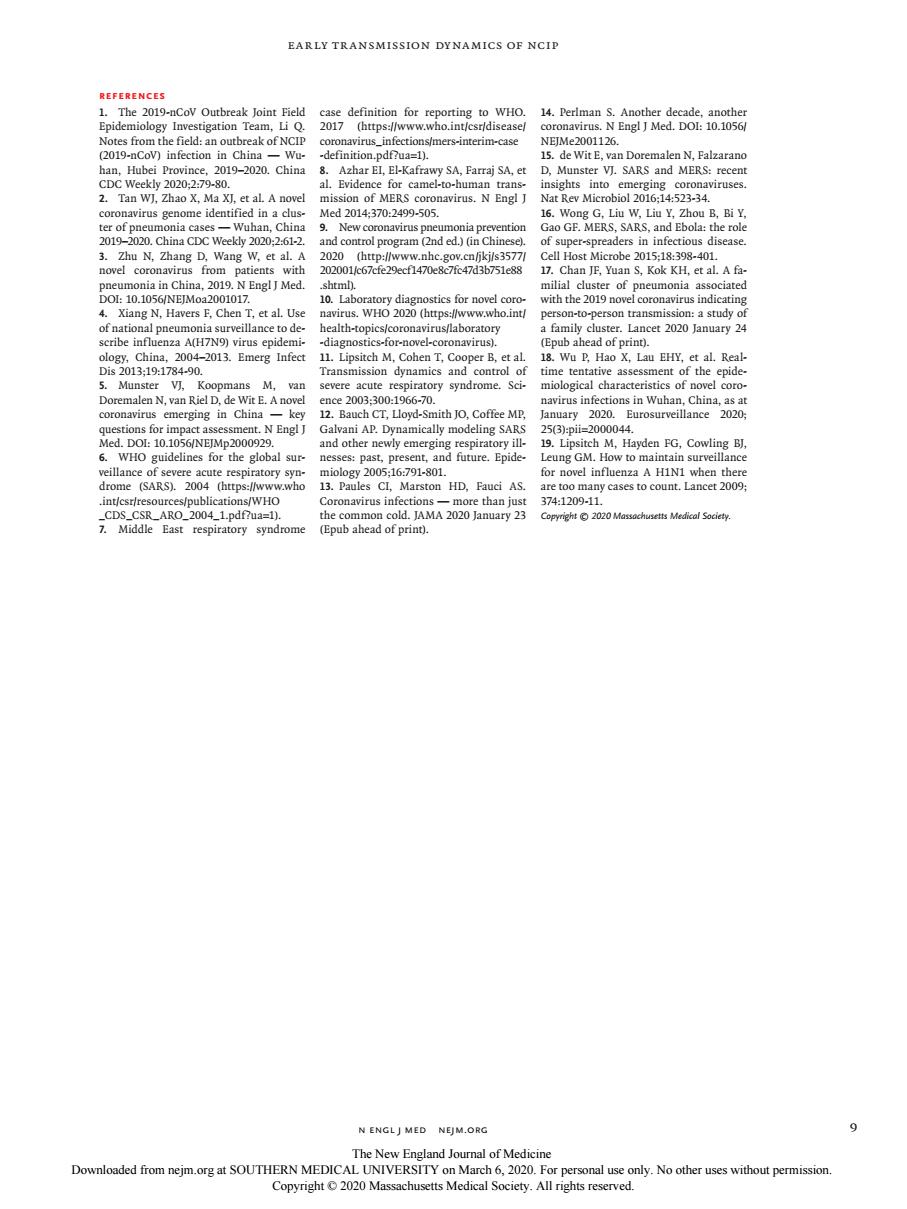正在加载图片...

EARLY TRANSMISSION DYNAMICS OF NCIP V).SARS a irus g d2014370:2 505 Wuhan.Chin Gao GF.MERS.SARS. Zhu N.Zhang D,Wang W,et al. progra 202 Cell Host Microbe1: who.int/ A(H7N9) D%011917490 013.Emerg Infect h M.Cohe and co China, 20 P. FG,Cowling B 16e791-801 for 374:12 9-1 res N ENGLI MED NEIM.ORO 9 nal of medici Downloaded MEDICAL.Fo onalusconly.NootherusesWithoutpemlsioan engl j med nejm.org 9 Early Transmission Dynamics of NCIP References 1. The 2019-nCoV Outbreak Joint Field Epidemiology Investigation Team, Li Q. Notes from the field: an outbreak of NCIP (2019-nCoV) infection in China — Wuhan, Hubei Province, 2019–2020. China CDC Weekly 2020;2:79-80. 2. Tan WJ, Zhao X, Ma XJ, et al. A novel coronavirus genome identified in a cluster of pneumonia cases — Wuhan, China 2019–2020. China CDC Weekly 2020;2:61-2. 3. Zhu N, Zhang D, Wang W, et al. A novel coronavirus from patients with pneumonia in China, 2019. N Engl J Med. DOI: 10.1056/NEJMoa2001017. 4. Xiang N, Havers F, Chen T, et al. Use of national pneumonia surveillance to describe influenza A(H7N9) virus epidemiology, China, 2004–2013. Emerg Infect Dis 2013;19:1784-90. 5. Munster VJ, Koopmans M, van Doremalen N, van Riel D, de Wit E. A novel coronavirus emerging in China — key questions for impact assessment. N Engl J Med. DOI: 10.1056/NEJMp2000929. 6. WHO guidelines for the global surveillance of severe acute respiratory syndrome (SARS). 2004 (https://www.who .int/csr/resources/publications/WHO _CDS_CSR_ARO_2004_1.pdf?ua=1). 7. Middle East respiratory syndrome case definition for reporting to WHO. 2017 (https://www.who.int/csr/disease/ coronavirus_infections/mers-interim-case -definition.pdf?ua=1). 8. Azhar EI, El-Kafrawy SA, Farraj SA, et al. Evidence for camel-to-human transmission of MERS coronavirus. N Engl J Med 2014;370:2499-505. 9. New coronavirus pneumonia prevention and control program (2nd ed.) (in Chinese). 2020 (http://www.nhc.gov.cn/jkj/s3577/ 202001/c67cfe29ecf1470e8c7fc47d3b751e88 .shtml). 10. Laboratory diagnostics for novel coronavirus. WHO 2020 (https://www.who.int/ health-topics/coronavirus/laboratory -diagnostics-for-novel-coronavirus). 11. Lipsitch M, Cohen T, Cooper B, et al. Transmission dynamics and control of severe acute respiratory syndrome. Science 2003;300:1966-70. 12. Bauch CT, Lloyd-Smith JO, Coffee MP, Galvani AP. Dynamically modeling SARS and other newly emerging respiratory illnesses: past, present, and future. Epidemiology 2005;16:791-801. 13. Paules CI, Marston HD, Fauci AS. Coronavirus infections — more than just the common cold. JAMA 2020 January 23 (Epub ahead of print). 14. Perlman S. Another decade, another coronavirus. N Engl J Med. DOI: 10.1056/ NEJMe2001126. 15. de Wit E, van Doremalen N, Falzarano D, Munster VJ. SARS and MERS: recent insights into emerging coronaviruses. Nat Rev Microbiol 2016;14:523-34. 16. Wong G, Liu W, Liu Y, Zhou B, Bi Y, Gao GF. MERS, SARS, and Ebola: the role of super-spreaders in infectious disease. Cell Host Microbe 2015;18:398-401. 17. Chan JF, Yuan S, Kok KH, et al. A familial cluster of pneumonia associated with the 2019 novel coronavirus indicating person-to-person transmission: a study of a family cluster. Lancet 2020 January 24 (Epub ahead of print). 18. Wu P, Hao X, Lau EHY, et al. Realtime tentative assessment of the epidemiological characteristics of novel coronavirus infections in Wuhan, China, as at January 2020. Eurosurveillance 2020; 25(3):pii=2000044. 19. Lipsitch M, Hayden FG, Cowling BJ, Leung GM. How to maintain surveillance for novel influenza A H1N1 when there are too many cases to count. Lancet 2009; 374:1209-11. Copyright © 2020 Massachusetts Medical Society. The New England Journal of Medicine Downloaded from nejm.org at SOUTHERN MEDICAL UNIVERSITY on March 6, 2020. For personal use only. No other uses without permission. Copyright © 2020 Massachusetts Medical Society. All rights reserved